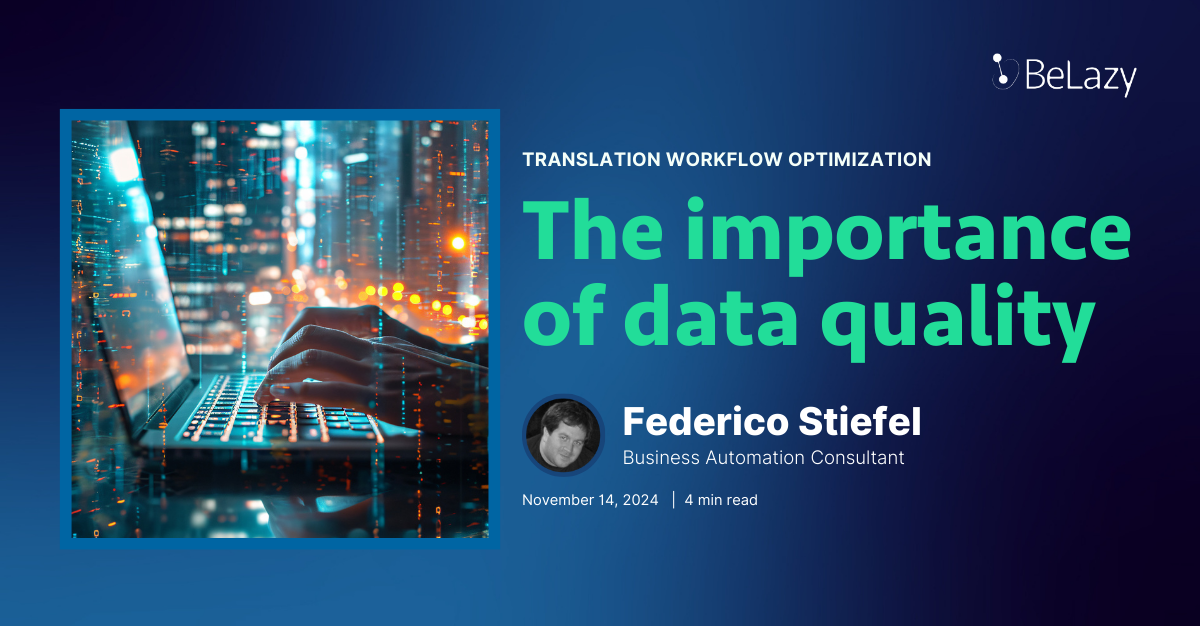The saying goes that companies looking to grow should not shy away from adopting new, emerging technologies. That’s the way to stand out from the crowd, improve your processes, save time and develop better interactions with your customers. One thing is talking the talk, and another is walking the walk.
Today we would like to present a translation company owner who did walk the walk: Nenad Andricsek, the owner of Translation Age, a Budapest-based language service provider that has been operating since 1991 and a BeLazy user since last September.
Nenad has always been enthusiastic about technology and process optimization, as a matter of fact, earlier this year, Nenad joined our team in a unique webinar session where we went over time-tracking tools & methods for language services providers.
In this interview, he shares more about his professional background and how he has managed to stay competitive in the language industry thanks to his automation-minded approach to business.
Your LinkedIn profile says you’ve started your career in localization back in 1998, as a Translation Project Coordinator for IBM. How has the industry changed since then?
There have been some fascinating developments in the past 20 years. Apart from the obvious ‐ machine translation, machine learning, and artificial intelligence ‐ we have seen major improvements in every single realm: CAT-tools like Trados and memoQ evolving from simple Word macros and becoming increasingly complex platforms, the rise of internet-based tools such as CMS connectors, Business Management Systems and so on!
For many years we kept people repeating that “soon there would be nothing else left to translate” but that hasn’t been the case — As a matter of fact, the demand for multilingual content keeps rising.
But the thing is today projects are smaller and turnaround faster. Back in the 2000s, it was quite usual to see incoming projects with 100k words and a delivery deadline of a month and a half. Today, you will see similar volumes but in 200 projects of 300-3000 words. This means a huge overhead for project management teams, but more control and traceability for the Client.
There’s also the ever-increasing pressure on prices. Still, I think that some clients pay premium prices for those services that really matter. In a way, it is good to see that the traditional human mind still holds high value.
Tell us about your company, Translation Age, who are your main clients?
We are a boutique Single Language Vendor (SLV) working almost exclusively on projects related to big corporate machinery that require speed, accuracy, quality, and specific subject expertise.
Many of the world’s largest Multilingual Language Vendors (MLVs) work with us, but we also collaborate on a regular basis with other SLVs. For instance, when we need to translate into Lithuanian which is just a few times a year, instead of looking for a freelancer, we go to our partners in the Baltic region. They do the same whenever they receive Hungarian projects. It makes more sense for both of us as we provide each other top-quality translations. It’s really a perfect match.
What language combinations do you work with?
We mostly deal with English into Hungarian, Bulgarian, Croatian, and Serbian. Then comes English into Slovak and Romanian. The source document is 95% English, but occasionally we see other language combinations as well, like Hungarian into Japanese.
When did you realize you needed to invest in automation?
In 2003, I created a process automation system for our IBM Translation Department which I believe over time saved the company thousands of dollars — To be honest, I never calculated it, but thanks to that I was able to do the job of a team of 5 for many years. It got me the chills! Ever since I’ve become an evangelist of that “automation philosophy” and try to apply it in other companies. The logic is simple: Invest in processes so that you can do more “while you sleep.”
As regards Translation Age, automation became essential when we started to work on multiple continuous localization projects at the same time. We currently have between 11 and 12 of those and frankly all the project management work would be impossible without automation — otherwise, we would need 2-3 more people involved.
Luckily we already had miniTPMS partially set up for that, so that was the obvious move to do.
What’s the most challenging part of the development?
Our biggest challenge was finding a way to connect Belazy with our platform through an API and making sure that while data is being transferred from one system to another, it still preserves the structure of projects as they are defined in our environment.
This required development efforts and testing. Testing was definitely the hardest part as one could only do so with real (live) data. Even if BeLazy provides testing templates, customers always end up sending something different, which may be completely unexpected.
We had to set up many rules and exceptions, so we came up with the idea of creating a generic integrator module, that can be used for other purposes as well. For instance, we’ve now used it to connect our platform with mailparser.io at a fraction of the actual cost. Of course, the initial investment was higher than average, but in the long run, it has been totally worth it. I’m really happy about it!
Why did you reach out to BeLazy? How did you actually know about us?
I’ve known István from his days at memoQ! But a few years ago, I met him again at ELIA Together in Barcelona and he introduced me to his new project (BeLazy). I found the idea pretty cool, as connectors to huge portals are always needed.
What are the benefits of this integration?
We are now able to save between 3 and 4 days a month on each of our continuous localization projects. This is a huge deal for small companies like us that can’t simply afford to hire additional project managers and most important of all, that want to avoid stressing their people by having them do extra hours all the time.
But apart from that, many other little things: most projects have already been processed by the system in the morning before we even start our shuffles, there are 90% fewer mistakes in data entry, tracking is easier, there is no longer the “I don’t want to enter all the same data all the time” feeling, and I could go on for some more too…
You’ve also produced a translation business management system for small & medium-size agencies called miniTPMS. Does it integrate with BeLazy?
Yes, we have connected BeLazy with our mini-integrator service (also works with mailparser.io) and we have never stopped since. Right now we’re deploying an automation workflow for one of our clients that helps them provide full traceability of their service. Whenever they assign a translator in miniTPMS (thanks to BeLazy) it automatically propagates this information into their client’s system. That kind of stuff gives me goosebumps 🙂
Translation Age has been around for over 30 years, what’s the secret to longevity?
I could go on about quality and all that Jazz, but the thing is quality means different things to different people. So, I rather “Do what the customer wants”. We learn, we adapt, and most importantly, we always use technology to our advantage.
I sometimes come across people (it’s rarer and rarer though) that still don’t use CAT tools but keep complaining about the number of projects they are able to handle. In such cases, I usually just take a deep breath and thank God that we made the right choices at the right time!
Why do you trust BeLazy as a technology partner?
For us, it’s a strategic partnership, just being in business with someone who knows this industry that well. He has already founded a very successful business (memoQ) and has always shared a passion for speeding things up, doing things the easier way. The saying goes that people buy services from those who they “know, like, and trust”. I think that’s pretty much the case here.







